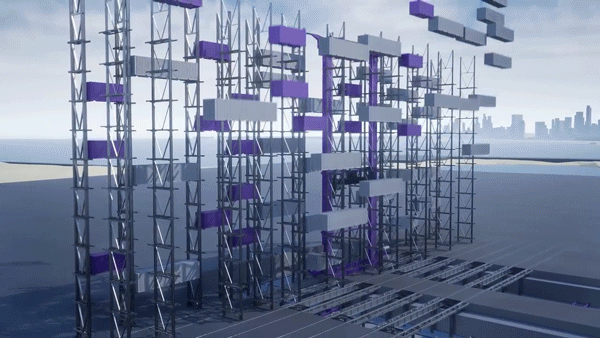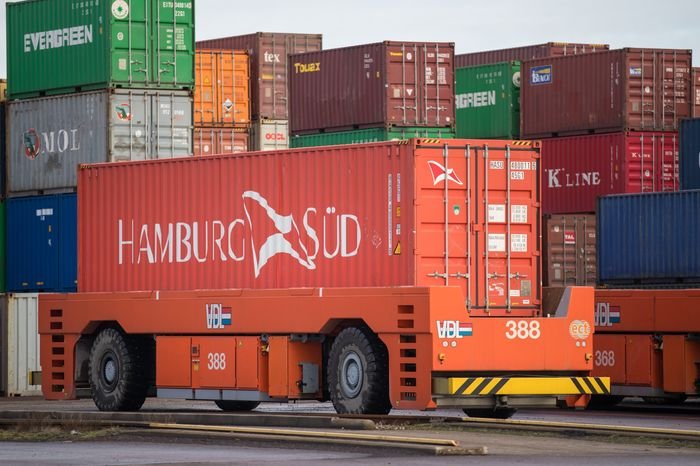Why Can’t U.S. Ports Get Automated?
American ports are behind Asia and Europe facilities in automating, but there are big hurdles to bringing robots to the docks.
U.S. officials say ports face hurdles in adding robots, including space constraints, tough economics and opposition from organized labor.
When cargo swamped Southern California’s big ports during the Covid pandemic, automated cranes and self-driving container carriers at the Long Beach Container Terminal swung into action.
The robotic equipment shuttled boxes from ships to growing stacks of containers on the docks and placed others on waiting trucks to carry them into inland distribution networks, efficiently handling the imports as cargo backups grew at other terminals at the ports of Los Angeles and Long Beach.
U.S. officials say ports face hurdles in adding robots, including space constraints, tough economics and opposition from organized labor. PHOTO: LAUREN JUSTICE/BLOOMBERG NEWS
The operation offered a modest moment of stability amid the disruptions and delays that racked U.S. supply chains from 2020 to 2022. Yet few container terminals in Southern California or around the country are pursuing similar forms of automation.
That is frustrating many shipping executives, who point to highly-automated gateways in Asia and Europe, including Shanghai’s Yangshan Port and the Port of Rotterdam in the Netherlands, as models of how automation can help break the bottlenecks that can arise at ports that handle thousands of containers every day.
Some executives say U.S. ports must automate to ensure that the country’s supply chains can remain competitive with other countries that include cost- and timesaving efficiencies from automation at their ports.
“It will happen, whether it is in two years or 20 years, otherwise as a country we can’t keep up,” said Jon Monroe, a consultant who until recently was the North American representative of Transfar Shipping, an ocean carrier backed by Chinese e-commerce giant Alibaba Group Holding.
But U.S. officials say the country’s ports face big hurdles in adding robots, including space constraints, the tough economics of getting a return on hefty investments and, most prominently, fierce opposition from organized labor.
The labor concerns at ports are part of the questions over automation arising in the broader industrial economy as businesses look to use more robotics in a range of logistics operations, from warehouse work to self-driving trucks. Wrangling over automation was one reason recent contract talks between West Coast dockworkers and their employers dragged on for more than a year before the two sides reached a tentative agreement in June.
Robotic vehicles haul containers at China’s heavily-automated Port of Tianjin. PHOTO: MARK SCHIEFELBEIN/ASSOCIATED PRESS
The hot-button issue is now shifting to the ports on the East Coast and Gulf Coast.
The leader of the union that represents East Coast and Gulf Coast dockworkers, the International Longshoremen’s Association, told a convention in July he intends to build an international coalition of maritime unions to stop automation in maritime operations.
“There’s going to be an explosion and the ILA and the dockers around the world are going to light the fuse,” ILA President Harold Daggett said. “It’s time we put companies out of business that push automation.”
Space is also a concern for U.S. facilities.
Major U.S. ports like Los Angeles, Long Beach and the Port of New York and New Jersey are hemmed in by sprawling metropolitan areas. They are expected to handle ever-growing volumes of cargo with no room to expand, a sharp contrast to some of the world’s most efficient ports, such as Khalifa Port in Abu Dhabi, that are built on greenfield or offshore sites where space is abundant.
The modern terminal at Long Beach can handle twice as many containers per acre than a conventional terminal. Yet it is one of just four terminals at Los Angeles-Long Beach, the nation’s busiest gateway for container trade, that have added automation or that say they plan to do so.
Operators at the other nine terminals at Los Angeles-Long Beach show little enthusiasm for automation.. The businesses, many controlled by ocean carriers or investment funds, say they can’t afford the billions of dollars needed for automated equipment.
They also say their terminals are too small or awkwardly shaped for automation to deliver the operating efficiencies that make an investment worthwhile.
“You’re going to give up a lot of terminal space while you are under construction,” said an official at a Southern California terminal who declined to be identified. “You’re going to have to sustain that loss of revenue for a period of time and getting the return on investment seems pretty difficult.”
A self-driving container carrier at the Port of Rotterdam, in the Netherlands PHOTO: JASPER JUINEN/BLOOMBERG NEWS
Other shipping industry leaders say efficiency gains from automation aren’t guaranteed. Although major U.S. ports such as Los Angeles lag behind peers in Asia in the number of containers they move per hour—a common industry measurement for efficiency—they perform about as well as other advanced ports such as Rotterdam.
Turloch Mooney, a director of S&P Global Market Intelligence, said automation allows ports to use land more efficiently and to deliver greater operating consistency. But, he said, “the idea that automation automatically leads to faster vessel turnaround times certainly isn’t the case.”





